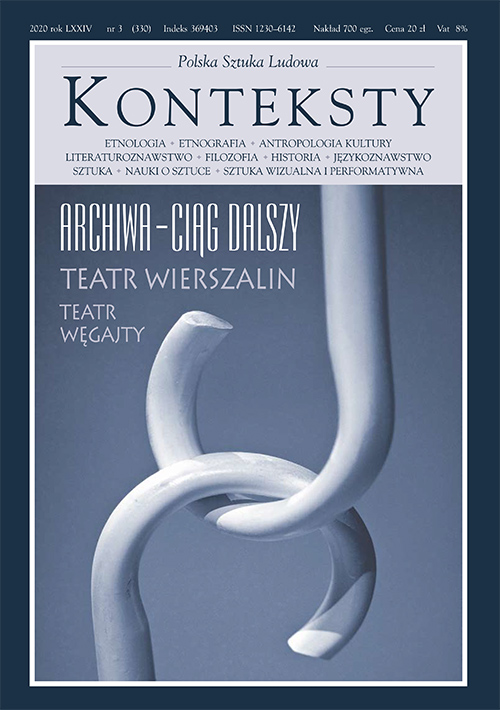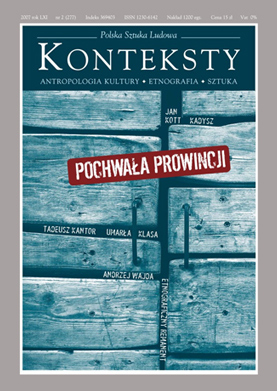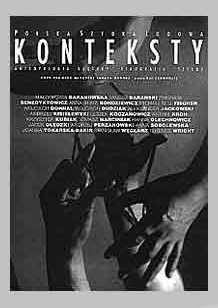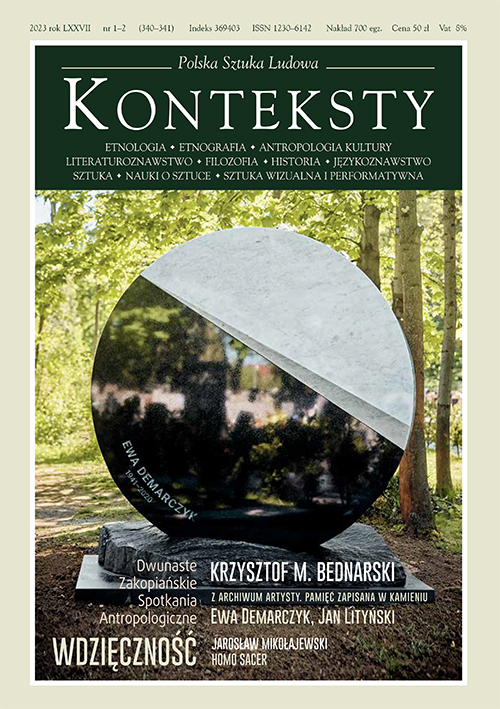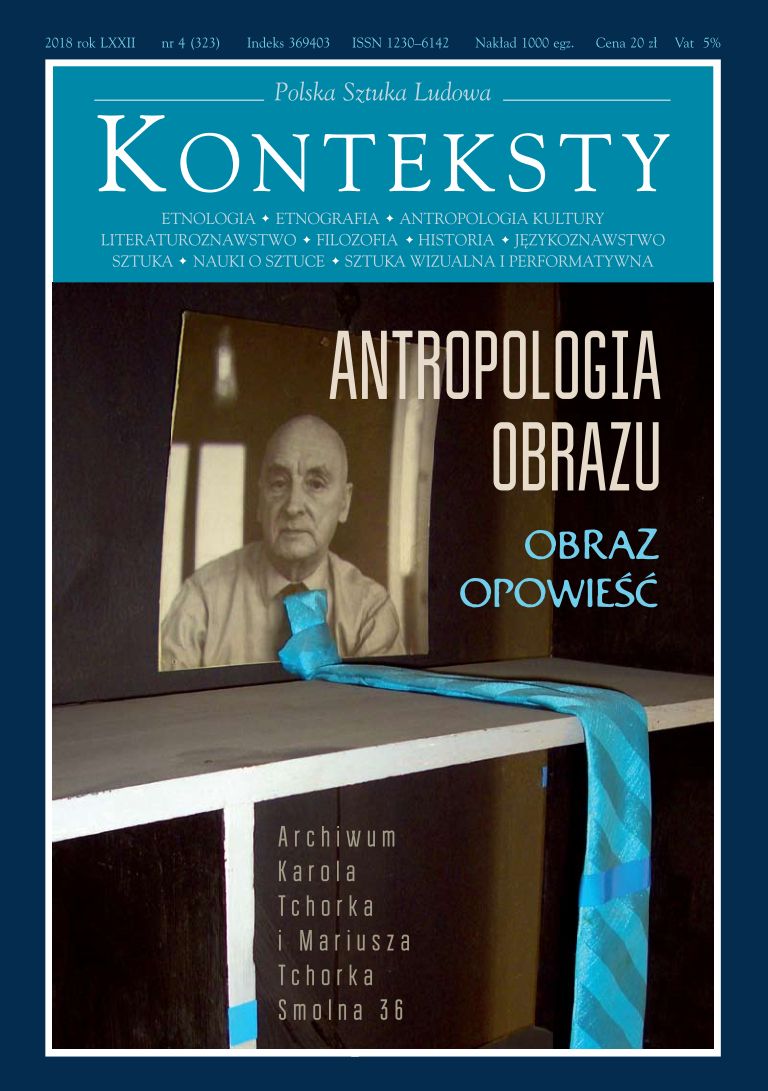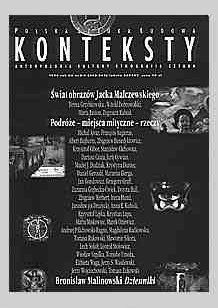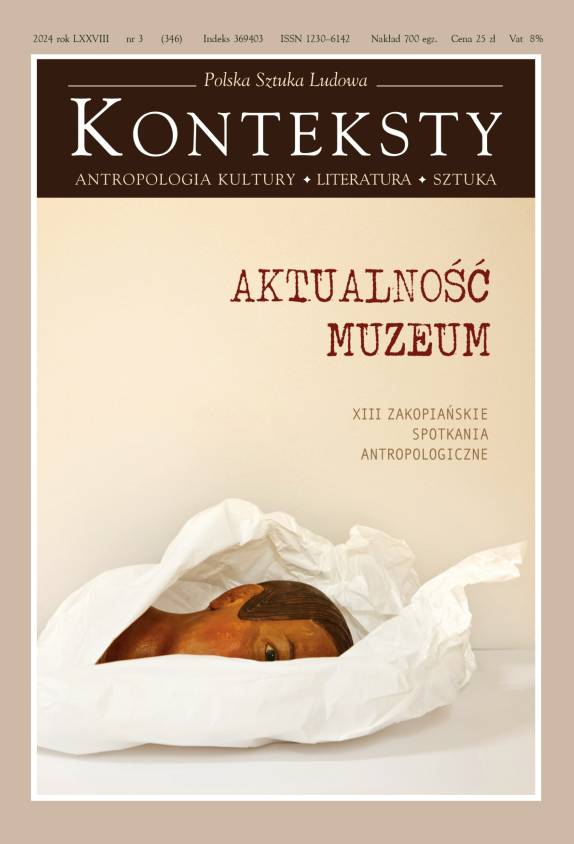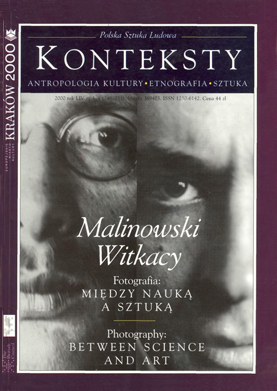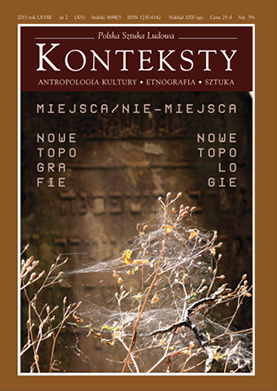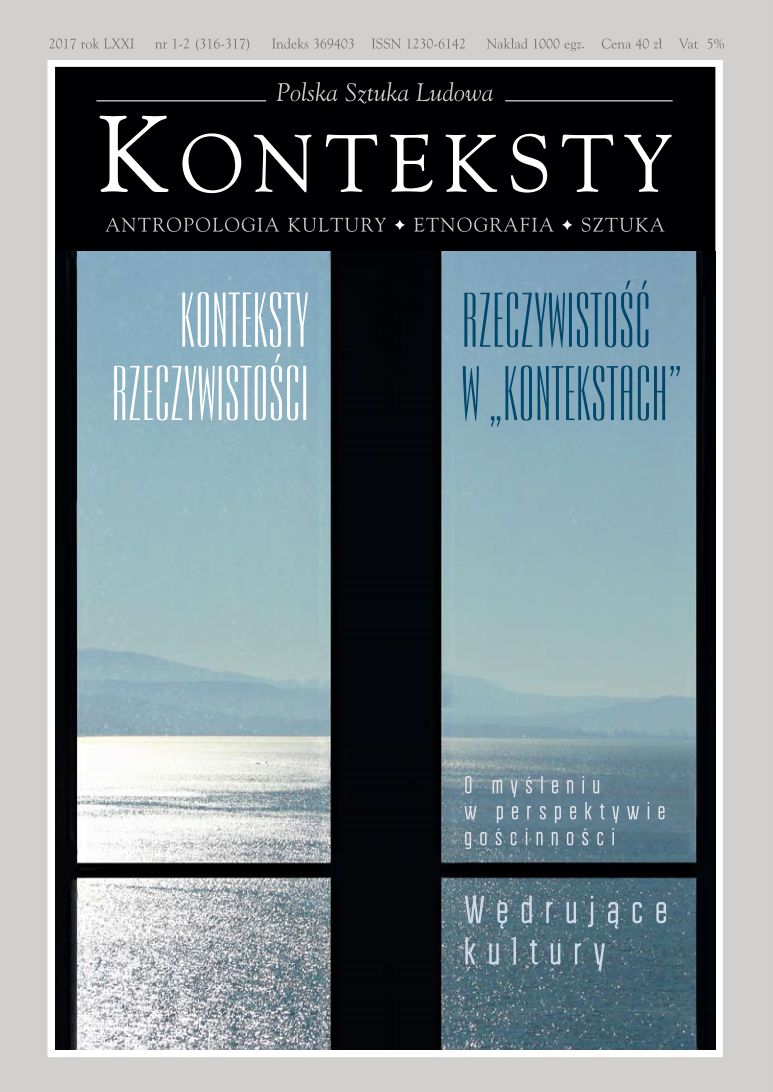Issue 2010/1 (288) -

| Wojciech Michera | The Death of the Image  | 3 |
Death” is not only a popular iconographic motif but also a category conceptually defining the ”image” itself. The presented text is a concise discussion of two dominating and, simultaneously, contradictory strategies of defining the relation between image and death. In accordance with the first (exemplified by the conception expounded by Hans Belting) the image in cultural praxis realises the principle of substitution and thus fills the gap caused by the impact of death. The second strategy (here the example is Maurice Blanchot, to whom Belting, as the author of the text proves, referred mistakenly), shows that ”death” (Blanchot's la ressemblance cadaverique) is an irremovable property of the ”image” as such. The text serves as an introduction to a block of material on Death of Images The title contains an ambiguous function of the genetivus (obiectivus/subiectivus): the metaphor of ”death” can refer both to the existence of the images and suggest the mortifying effect of their activity. | ||
| Joseph Leo Koerner | The Mortification of the Image: Death as a Hermeneutic in Hans Baldung Grien  | 7 |
A translation of an English text by a professor at the Harvard Faculty of the History of Art and Architecture, an outstanding expert on art of the German Renaissance. | ||
| Andrzej Leśniak | The Concealed Images of Alfredo Jaar. The Configuration of the Visible  | 32 |
The installations of the Chilean artist Alfredo Jaar make it possible to discuss tragedy as a problem. Jaar examines the effects of traumatic events and analyses documentary material, media messages and landscapes of crime. Two works considered in this essay: Real Pictures and Untitled (Newsweek) refer directly to the civil war in Rwanda. Immediately after the hostilities came to an end, the artist spent several months in the ravaged country where he took photographs of the survivors, collected reports and amassed material, conceived as a future archive of the events. Ultimately, the archive never came into being – material traces proved to be too controversial and the very possibility of taking a stand towards recent history became questioned. The discussed works by Jaar demonstrate the significant part played within this concept by the media, which simultaneously produce an illusion of a tide of information and ignore those events that do not fit into the frame of the constructed spectacle. | ||
| Agata Sierbińska | The Constructions of Memory: the “Postmemory” of Marianne Hirsch, the Postmemory of Christian Boltanski  | 39 |
A presentation of the category of „postmemory” and an attempt at studying its usefulness as an interpretation instrument. Marianne Hirsch, the author of the conception of „postmemory”, claims that it describes the experience of „mediated memory” (constructed post factum, upon the basis of narration and images), which is not encompassed by the traditional philosophy of memory. The interesting but theoretically non-cohesive construction proposed by Hirsch is confronted with the works of Christian Boltanski – an artist whose oeuvre embarks upon an attempt at recreating lost memories and, at the same time, via a number of assorted operations, aptly diagnoses the very essence of mediated memory. The outcome of this confrontation is a verification of the premises formulated by Marianne Hirsch, the outfitting of her conceptions with a strictly theoretical framework, and, finally, the re-formulation of the definition of „postmemory”. | ||
| Antoni Michnik | Greenaway, the Cinema, its Death and Consequence. The Contexts of the ”Tulse Luper Suitcases”  | 53 |
The text deals with a multi-media project by Peter Greenaway, whose core is composed of the Tulse Luper Suitcases trilogy. The presentation takes place within the context of a manifesto proclaimed by Greenaway in Milan on 28 August 2003 announcing „the death of the cinema”. A further part of the text ponders on the meaning of the victory of death for the Greenaway project, situating the latter amidst the director’s earlier films and works by contemporary artists, in particular Christian Boltanski and Ydessa Hendeles. The project proposed by Greenaway becomes a voice in the current debates conducted in the world of the arts, focused on the presentability, or not, of death, the meaning of its imagery and, finally, the condition of the image itself. | ||
| Szymon Wróbel | The Effort of Thinking as a Ritual of Delaying Death  | 64 |
Where should we seek the archaeological sources of the representative system? Are these skills inserted into our behavioural and even emotional behaviour, since in accordance with Freud’s suggestion we should look for the sources of human symbolism in defensive mechanisms that allow us to heal the first painful wounds suffered by our narcissism? Since in the beginning was the drive, then representation appears to be merely a perception of the drive; on the other hand, since in das Es we come across only representations of drives and not the drive itself, then the life of representation appears to precede that of the drive forces. Or should we search for the sources of our human symbolism in language systems, i. e. the ability to produce an endless sequence of sentences and to refer it to the world, as has been suggested by Chomsky? The fundamental purpose of this study is offer solutions to the above questions and, consequently, an attempted confrontation of a psychoanalytical and a cognitivistic discourse. I maintain that the superiority of the psychoanalytical discourse consists mainly of the fact that it tries to understand the origin of representation avant la lettre, i. e. to comprehend the nature of representation before the latter started to fulfil orientation (representative) functions vis a vis the outer world. More, I claim that the basic paradox of the human representative system is the fact that representation, whose initial yardstick is an escape from the world of drives, is to become an instrument whose ultimate measure is adequacy. Representation, whose original function was the prolongation of the existence of more powerful and more primeval forces (i. e. drives), is supposed to become a representation of something that is diametrically dissimilar and ontically totally alien – the outer world. In a psychic apparatus, representation, which was the externality of the world of Nature (the body), was to turn into an inner simulation of externality (Nature). Hence the possibly rash but inevitable conclusion, namely, that representation is a fold, a knot, a bow, a stratification and a crisis, wherein the elements of the natural world meet, albeit experienced from two sides: that of the body and that of the world. That which we call an interior (representation) is only the outcome of a clash of two tectonic plates of the world of Nature: the physics of the outer world and the biology of the corporeal world. Such a geographic situation of representation in the world finally permits us to conduct a thorough reconstruction of the contents of its concept. | ||
| Tomasz Swoboda | Prolegomena to the History of the Eye  | 71 |
A proposal to consider the significance of the motif of the eye in the works of Bataille and writers from his circle. The recognised characteristic features of the motif include its association with the sacrum and a materialistic treatment of the organ of sight. The eye is inscribed also into the topos of the inexpressible and the erotic discourse of the author of Madame Edwarda. In all instances, the source of the „percepts” proved to be a borderline sense, proof of transformations in contemporary philosophy and aesthetics. | ||
| Tomasz Swoboda | The Seen Eye  | 84 |
A text on the motif of the eye in the oeuvre of Georges Bataille, Maurice Blanchot and Michel Leiris. With an image of Batailles’ eyes as his point of departure, the author recalls the part played by the observed eye in the conception of the contemporary subject. Further on, he outlines the contact of the eye and the dark night in works by Blanchot and Leiris. | ||
| Jan Gondowicz | The Magic Goddess of the Body  | 95 |
This sketch develops a thesis proposed in the book Bruno Schulz, issued in 2006, which tries to prove that Schulz’ series of graphic works entitled Xięga bałwochwalcza illustrate a pseudo-mythical tale about theophanies in the phantasmagorical Drohobycz of the Phoenician goddess Astarte. According to this conception, the young Schulz devised, together with a group of friends, a unique experimental religion of ecstasy. The presented study attempts to seek evidence in favour of this concept in the „scandalizing” backdrops of Schulz’ portraits and self-portraits. The reconstruction of the erotic rituals of the ancient Middle East could have referred to Les Mysteres des Dieux, Venus (1909) by the eminent French occultist Pierre Piobb, which appeared in Poland already a year after its publication. | ||
| Elżbieta Łojszczyk | The ambiguous resolution of vegetal nature. Mimicry strategy’s in the works of Hans Bellmer and Bruno Schulz  | 105 |
The article takes up problem of representation in terms of signifiance, picture and matter, which are connected to the doll / mannequin subject in the works of Hans Bellmer and Bruno Schulz. Łojszczyk makes consideration in contexts of Freud’s theory of instincts and mimicry conception by Roger Caillois against a background of contemporary French philosophy of difference. The main idea is a question of anagrams and poetry of nightdreams. It recognize, in a comparatistic way, the common philosophy of radical immanence and apply it to the body emancipation in sense of sovereign plane, beyond the limits of discourse and classical system of reference. | ||
| Szymon Uliasz | The Pulsating Plate  | 120 |
The proposed attempt at reconstructing Tadeusz Kantor’s last spectacle Today is My Birthday is based on the mechanisms of photographs and human memory – the recreation and capturing of reality in a crooked and grotesque mirror, the distinction of the recollection as such and the reviving of reminiscences. Their imagined existence is evidence of the pulsating plate, while the consigning instance is the artist’s memory. The text is not so much presented as discussed, abandoned and then rhythmically revived, both in Kantor’s work and in the presented study. Such deciphering is steered by a re-interpretation of Kantor’s oeuvre in the light of publications by M. Pieniążek, R. Barthes, G. Didi-Huberman and S. Sontag, as well as a polemic with experts on Kantor. The article undertakes a survey of the artistic inspiration of Tadeusz Kantor, indissolubly connected with his life, in which death is perceived as an inevitable element. The remnants of disintegration and destruction enacted on the stage created for Kantor an aesthetic and artistic domain for conducting a quest. While creating his representations and multiplying doppelgangers, Kantor produced photographs on the plates of theatrical spectacles, thus revealing the intimate and dark corridors of his memory. As a defender and adherent of the qualities of reality he claimed that in the theatre reality might exist exclusively thanks to illusion. | ||
| Łukasz Zaremba | Peculiar Images  | 130 |
The characteristic feature of the ethnographic works by Joanna Tokarska-Bakir is a certain paradox. On the one hand, they concentrate on images, which in itself is a rather exceptional approach in Polish anthropology of culture. On the other hand, the author’s research declaration appears to be, to a great extent, pretence, since the „image” appears to be a mere backdrop or a pre-text in relation to the text proper, and ultimately it disappears altogether. The presented essay discusses a research approach to the category of the image in Tokarska-Bakir’s celebrated book: Obraz osobliwy. Hermeneutyczna lektura źrodeł etnograficznych, her most recent Legendy o krwi (especially the chapter on the so-called Sandomierz paintings) and the film A Pole in a Wardrobe by Artur Żmijewski who cooperates with the anthropologist. The point of departure, however, is a fundamental relation to the examined phenomenon, and thus to the studied people as well as certain initial assumptions concerning the terrain of the research, the method and the position of the researcher. The text suggests that the selection of a traditional „terrain” and the course of conducting anthropological studies conceal also certain traditional presuppositions about the essence of the examined phenomenon (in this case, Polish anti-Semitism) and, simultaneously, the very essence of ethnography. While dealing with the image the author focused on silently accepted and unfounded opinions and premises concerning images in works by Tokarska-Bakir. He argues (by using, i. a. the categories proposed by the anthropologist in her Obraz osobliwy) that a certain reception of images (naive, wild and non-distinguishing) cannot be ascribed to any social group distinguished due its education, place of residence or age, but is just as strongly present in the relation of Joanna Tokarska-Bakir and her students to the paintings from Sandomierz depicting ritual murders. | ||
| Olga Kaczmarek | “Invisible Spectacles”. Legends about Jewish Ritual Murders as Performance  | 140 |
One of the features of blood libel legends is their exceptional historical permanence and elasticity, which makes it feasible to expand the basic scheme and adapt it to local circumstances, inter-group relations and existing images. An analysis of this phenomenon from the viewpoint of a performative perspective allows us to treat the situation of narration as an event involving participants, in accordance with the performance formula devised by Richard Bauman. On the other hand, we take a closer look ar the causal potential of those stories as acts of speech, transcending the frames of a single-occasion performance. The fundamental material source material consists in this case of interviews concerning the Orthodox saint, Gabriel Zabłudowski, conduced by the author in the county of Hajnow (the Podlasie region). | ||
| Wojciech Michera | Image, Crypt, Interpretation  | 152 |
The ”crypt” is a concept introduced in the 1960s into psychoanalysis by N. Abraham and M. Torok, and additionally discussed by J. Derrida. It radically complicates the traditional ”consciounsess-subconcsiousness” topos since it is not yet another metaphor of the ordinary unconsciousness but its ”artificial” variant, which linguistically resists the efforts of the analyst The author first proposes to treat the psychoanalytical process, striving towards disclosing the unconscious contents of the symbol, as a working model for all sorts of interpretations of the text/narrative image. Next he ponders on the manner in which this model becomes complicated when one takes into account the category of the ”crypt” as well as other related conceptions borrowed from the Abraham and Torok theory and Derrida (introjection, incorporation, phantom, haunting). | ||
| Jules Champfleury | Guardian of Wax Figures  | 159 |
A translation of Champfleury’s novel L’Homme aux Figures de Cire from 1852. | ||
| Tomasz Szerszeń | On the Unusual Portraits and Life of Stefania Gurdowa, ”Rzeczy” and Ethnographic Photography – a Recorded Interview with Andrzej Kramarz | 168 |
| Jerzy Lewczyński | The Need for a Secret  | 173 |
A statement by the renowned Polish photographer and author of the term „the archaeology of photography” about photographs taken by Stefania Gurdowa and what can be deciphered from accidentally discovered anonymous photographs. | ||
| Jerzy Łoziński | The Presence of the Absent  | 175 |
Impressions associated with tours of Rijksmuseum in Amsterdam and museums in Koln and The Hague. | ||
| Janusz Barański | The Non-disposability of the Object | 180 |




